By Jeffrey A. Rendall, Photos By Kevin Gaydosh
WILLIAMSBURG, VA -- Most people would agree, golf's the sport of a lifetime. You can learn it as a child, refine your skills over the years, and God-willing, enjoy it 'til your dying day.
Part of what makes the sport special and unique is its social aspect. There's something to be said about playing a round in the late afternoon all by your lonesome, but much more enjoyment comes from joining up with your favorite foursome to play eighteen together. Some might even call your buddies your golfing 'family.'
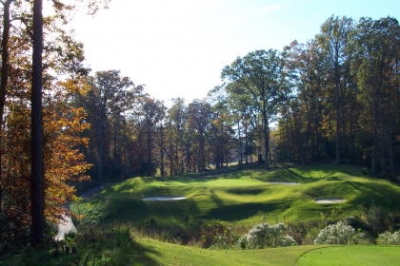 |
| Sunlight and shadow silently emphasize Jones' eye for contour on the Green Course's par three 7th hole. |
And for the very fortunate, golf's more than just a sport -- it is family. Such is the case for Rees Jones, son of legendary course designer Robert Trent Jones (Rees has certainly established a good name for himself with his own design work).
And there's no better place to get the Jones 'familial' feeling than at Colonial Williamsburg's Golden Horseshoe Golf Club, which features the Gold Course, designed by the father (and redone by Rees in 1996) and the Green Course, designed by the son.
Rees Jones says his relationship with the Colonial Williamsburg folks is more than just a designer/client partnership -- it's more like a family. "The Golden Horseshoe project will always be one of my favorites, not only for building the great golf courses, but also because of the people involved. I always enjoy going down there because the people who run the facilities really love the game. It was the same for my Dad -- he and my Mom used to spend weekends there when he was working on the Gold course. You could say we all feel at home in Williamsburg."
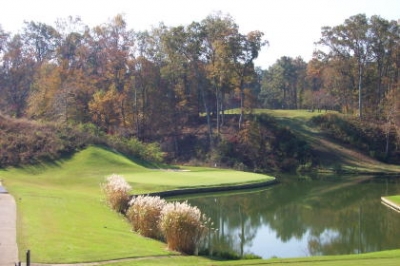 |
| It's safe to say, the Gold Course's par threes are world famous. Here, the 12th hole. Any shades of Augusta National here? |
The elder Jones loved it so much, in fact, that he often spoke of the Gold Course as being his 'finest design.'
Jones continues, "Over the years we've gotten to know a lot of the Colonial Williamsburg folks, and they've sort of made us part of their family. That's very special. It's been an honor to work for them, because everything they do is of the highest quality."
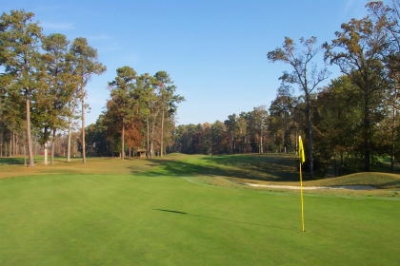 |
| Everything about the Gold Course exudes tradition. Jones says the layout conforms to the land like the courses in the old country. Mix in the beautiful Virginia setting, and you've got perfection. Here, the par four 4th hole. |
The Golden Horseshoe's ever- evolving search for perfection was first revealed to Rees in the architect selection process. Jones elaborates: "I think when the Colonial Williamsburg Board decided to build the Green Course, they thought it would be nice to have a father-son combination of designers -- but that was only one part of their thinking. Each of the architect finalists got to play one of their golf courses with the decision-makers, to kind of explain their philosophies. It was the most involved process for selecting a course designer I've ever been associated with."
The results prove the process was a sound one. The Green Course is a fine complement to the Gold, offering many of the same qualities without duplicating the older layout. The Green is somewhat longer than the Gold, but much wider. And like the Gold, it's got a great blend of serenity, playability and challenge.
Jones says he designed the course to play on top of the ridges of the very undulating ground: "My Dad's course was situated on a flatter piece of land, so I needed to use more acreage when designing the Green Course. Because there were so many ravines, I routed the holes along ridge lines, and occasionally worked the drop-offs into the design."
But fitting in the course was never a problem, because the Williamsburg 'family' offered Rees plenty of resources to work with, namely land. Jones says, "It really helped, when building the Green Course, that we had such a long-standing relationship with the people we were working for. They gave us all the land we needed, and provided the people we wanted to make the project match its potential."
"One neat thing about the project -- we used the same construction contractor (Austin Gibson) that my Dad had used to build the Gold Course in the early sixties, then hired him again when we touched up the Gold in the mid-nineties. It gave the work a real continuity."
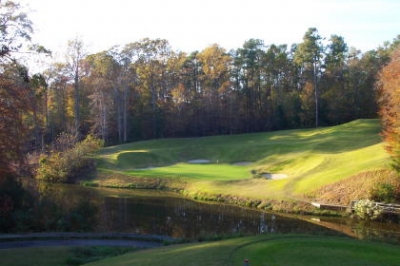 |
| The Green Course's par three 11th hole. The amphitheater of golf. |
You can tell Jones was pleased with the outcome: "The Green Course is like a nature walk. It's just natural woodlands with holes cut through it, and there isn't a house in sight. It's truly an escape from everyday routine, which is what golf is really all about."
Because of the ravines, he placed mounding on the sides of the fairways to help prevent wayward shots from reaching the extremes. It's the same type of mounding you'll see on many Rees Jones creations, and kind of lets you know he's been in the neighborhood.
The Green Course alone is incentive enough to visit the Golden Horseshoe, but when put in conjunction with the timeless classic Gold Course (which opened in 1963), it's an incredible combination. And when the Gold needed some modifications a few years back to bring the course up to modern technological standards, Rees Jones was the right man for the job. After all, it was a 'family' project.
Jones says his Dad created a masterpiece, and he sought only to enhance it. "There's no doubt in my mind that the Gold Course deserves mention on the list of great courses in Virginia. But in order to make it more playable for a resort course, we needed to change a few things -- to modernize it."
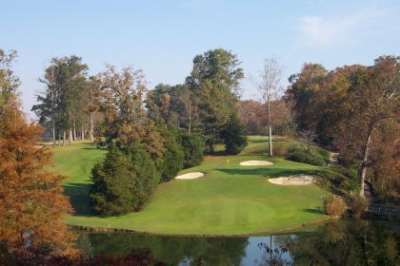 |
| The Jones family favors carries to par threes -- adds a memorable quality to practically every one-shotter you'll see. Here, the Gold's 7th hole. |
"First off, we replaced all of the greens. They were too small to endure the type of play the course was getting, so we added tongues on some of them to provide for championship pin placements, as well as cover the maintenance issues. We also took out the fall-away qualities, which makes the green complexes a little more forgiving. Second, we re-graded some of the fairways to provide for better visibility, and to allow them to flow in the direction the hole goes. Finally, we improved the bunkering around the greens (added some and deepened others)," Jones said.
Jones says when the Gold Course was originally built, his father didn't have the budget to do the extensive fairway grading found in most newer vintage courses. The redesign work was the same type of 'upgrade' he performed on some of his Dad's other legendary layouts, such as Congressional Country Club (hosted the US Open in 1997 and 2011) and the Atlanta Athletic Club (hosted the 2001 and 2011 PGA Championships).
"They just didn't do those types of things in the old days because the money wasn't put into courses like it is now (speaking of fairway grading). The Gold Course is an incredibly natural layout that just seems to sit perfectly on top of the landscape -- just as the courses do in the British Isles. And because most courses don't have caddies anymore, players need to be able to see the target they're shooting at. All we did was make it a little more playable for the average resort player. Dad's routing remains completely intact, with all its strategic qualities."
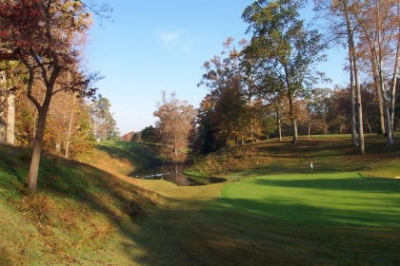 |
| Natural colors enhance the Gold's par three 3rd hole. What the image doesn't show is how steep the green is. |
One thing he didn't alter in a significant way is the Gold's green contours. Jones says he made some greens more undulating and others less -- but to make them too flat would take away some of the course's difficulty. The Gold course, short by today's standards, needs undulation in the greens to keep its defenses against dramatic improvements in equipment and golf balls.
Resort courses often cater to people who play them occasionally while on vacation. But the Golden Horseshoe also has a healthy membership. Jones says the changes allowed both types of players to be satisfied: "The Gold Course is an examination. You don't want to build courses that people only want to play one time. Members want to play golf courses of continuing pleasure and interest. And I think that's what they've found at the Gold -- it's even more pleasurable than it used to be, and it's just as challenging now."
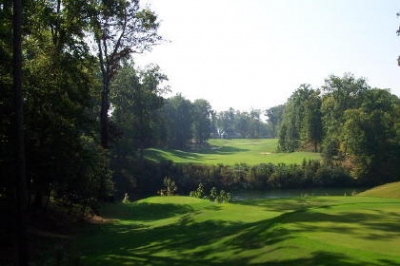 |
| The Green Course's par five 18th hole is one heckuva finish. If you drive it safely here, it's definitely a birdie hole. |
As a final note, Rees said his father approved of the changes. "When we worked on the Gold Course, Dad wasn't really able to come to the site to see what we were doing. But I told him about the changes, and he was pleased. He'd been very complimentary of my work at Congressional, so I'm glad we were able to make his already excellent work even better."
It's always nice for a son to have his father's approval, especially when talking about altering a landscaped piece of art like the Gold Course. But in the case of the Golden Horseshoe, there's already a considerable amount of family harmony. And if you don't get that feeling just from playing the golf courses, you'll certainly get it when seeing the overall quality a visit to Virginia's Colonial Capitol presents -- it's an 'All in the family' experience, through and through.
For more information on Rees Jones, try: www.ReesJones.com, or check out the GolfTheUnitedStates.com profile of Mr. Jones.
Details:
Golden Horseshoe Golf Club's Gold & Green Courses
401 South England Street
Williamsburg, VA 23185
Phone: (757) 220-7696
Website: www.colonialwilliamsburg.com
Course Designers: Robert Trent Jones and Rees Jones
Head Golf Professionals: Jeff Winters, PGA
Director of Golf: Glen Byrnes, PGA
Special thanks to Rees Jones, Glen Byrnes, Carol Godwin and Ed Allmann in preparing this story.
| Related Links | Comments on this article? | |
|
Maryland National Golf Club Hollow Creek Golf Club Rocky Gap Resort PB Dye Golf Club in Ijamsville Whiskey Creek Golf Club |
E-mail Jeff Rendall, Editor: jrendall@golftheunitedstates.com |












